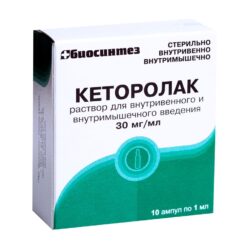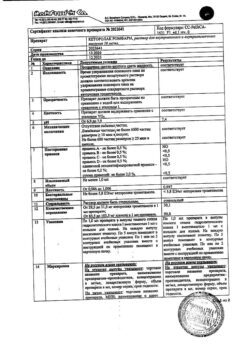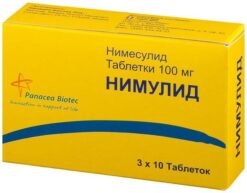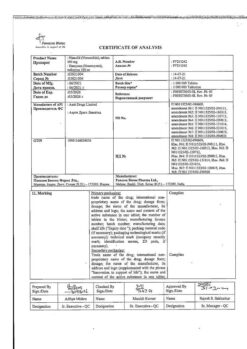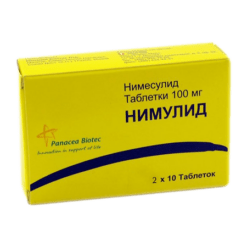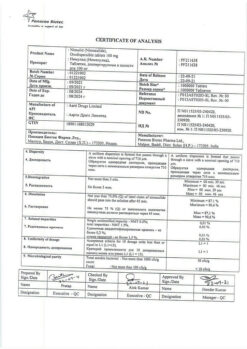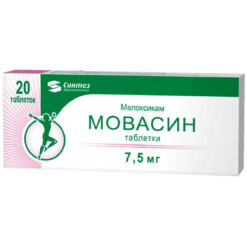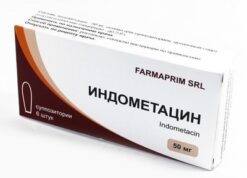No products in the cart.
Texared, 20 mg 10 pcs
€12.65 €10.54
Description
Tenoxicam, which is a thienothiazine derivative of oxycam, is an NSAID. In addition to its anti-inflammatory, analgesic and antipyretic effects, the drug also inhibits platelet aggregation. Tenoxicam exerts its anti-inflammatory effect by inhibiting the activity of COX isoenzymes involved in arachidonic acid metabolism and thereby suppresses PG synthesis.
Tenoxicam has no effect on the activity of lipoxygenases. In addition, tenoxicam suppresses some functions of leukocytes, including phagocytosis, histamine release and decreases the content of active radicals in the inflammation focus.
Pharmacokinetics
The drug is rapidly absorbed from the gastrointestinal tract in unchanged form. Cmax is reached 2 hours after drug intake. When the drug is taken after meals or together with antacids, the rate but not the degree of absorption is reduced. The average T1/2 is 70 h. Tenoxicam is fully absorbed, its bioavailability is 100%. In the blood the drug is 99% bound to proteins.
The drug penetrates well into the synovial fluid and is characterized by low systemic clearance and prolonged T1/2, which allows Tenoxicam to be taken once a day.
2/3 of the taken dose of the drug is excreted with urine, 1/3 with feces. There is no cumulation of tenoxicam when prolonged use; serum content of the drug in this case is 10-15 µg/ml.
Indications
Indications
rheumatoid arthritis, osteoarthritis, ankylosing spondylitis, articular syndrome with exacerbation of gout, bursitis, tenosynovitis;
pain syndrome (weak and moderate intensity): arthralgia, myalgia, neuralgia, migraine, toothache and headache, algomenorrhea;
pain from injuries, burns;
inflammatory and degenerative diseases of the musculoskeletal system, accompanied by pain, such as sciatica, lumbago, epicondylitis.
Intended for symptomatic therapy, reducing pain and inflammation at the time of use, does not affect the progression of the disease.
Pharmacological effect
Pharmacological effect
Tenoxicam, a thienothiazine derivative of oxicam, is an NSAID. In addition to anti-inflammatory, analgesic and antipyretic effects, the drug also prevents platelet aggregation. Tenoxicam exerts its anti-inflammatory effect by suppressing the activity of COX isoenzymes involved in the metabolism of arachidonic acid, and thus suppresses the synthesis of PG.
Tenoxicam does not affect the activity of lipoxygenases. In addition, tenoxicam inhibits some functions of leukocytes, including phagocytosis, histamine release and reduces the content of active radicals at the site of inflammation.
Pharmacokinetics
The drug is quickly absorbed from the gastrointestinal tract unchanged. Cmax is reached 2 hours after taking the drug. When taking the drug after meals or together with antacids, the rate, but not the extent of its absorption, decreases. The average T1/2 is 70 hours. Tenoxicam is completely absorbed, its bioavailability is 100%. In the blood, the drug is 99% protein bound.
The drug penetrates well into the synovial fluid, is characterized by low systemic clearance and long T1/2, which allows tenoxicam to be taken once a day.
2/3 of the taken dose of the drug is excreted in the urine, 1/3 in the feces. With long-term use, accumulation of tenoxicam is not observed; The serum content of the drug is 10–15 mcg/ml.
Special instructions
Special instructions
During treatment, it is necessary to monitor the picture of peripheral blood and the functional state of the liver and kidneys, the prothrombin index (against the background of indirect anticoagulants), and the concentration of glucose in the blood (against the background of oral hypoglycemic drugs).
If it is necessary to determine 17-ketosteroids, the drug should be discontinued 48 hours before the study.
A few days before surgery, the drug is discontinued.
It is necessary to take into account the possibility of sodium and water retention in the body when prescribing diuretics to patients with arterial hypertension and CHF.
To reduce the risk of developing adverse events from the gastrointestinal tract, the minimum effective dose should be used for the shortest possible short course.
Influence on the ability to drive vehicles and operate machinery. One of the undesirable effects of the drug is dizziness; this should be taken into account in situations that require close attention of the patient, for example when driving a vehicle or complex technical devices. During the treatment period, care must be taken when driving vehicles and engaging in other potentially hazardous activities that require increased concentration and speed of psychomotor reactions.
Active ingredient
Active ingredient
Tenoxicam
Composition
Composition
Film-coated tablets:
active substance:
tenoxicam – 20 mg,
excipients:
lactose monohydrate – 90 mg;
corn starch – 70 mg;
pregelatinized starch – 16 mg;
talc – 3 mg;
magnesium stearate – 1 mg,
film coating: Opadry OY-S 22989 yellow – 5.6 mg; hypromellose – 2.9 mg; titanium dioxide – 1.8 mg; macrogol 400 (polyethylene glycol 400) – 0.3 mg; iron oxide yellow – 0.6 mg.
Contraindications
Contraindications
hypersensitivity;
erosive and ulcerative lesions of the gastrointestinal tract (including a history);
gastrointestinal bleeding (including history);
severe gastritis;
complete or incomplete combination of bronchial asthma, recurrent polyposis of the nose and paranasal sinuses and intolerance to acetylsalicylic acid or other NSAIDs (including a history);
hemophilia;
hypocoagulation;
liver and/or renal failure (creatinine Cl less than 30 ml/min);
inflammatory diseases of the gastrointestinal tract;
progressive kidney disease;
active liver disease;
condition after coronary artery bypass surgery;
confirmed hyperkalemia;
hearing loss;
pathology of the vestibular apparatus;
deficiency of glucose-6-phosphate dehydrogenase;
blood diseases;
pregnancy;
lactation period.
With caution: chronic heart failure; swelling; arterial hypertension; diabetes mellitus; coronary heart disease; cerebrovascular diseases; dyslipidemia/hyperlipidemia; peripheral arterial disease; smoking; chronic renal failure (Cl creatinine 30–60 ml/min); presence of H. pylori infection; long-term use of NSAIDs; alcoholism; severe somatic diseases; simultaneous use of oral corticosteroids (including prednisolone), anticoagulants (including warfarin), antiplatelet agents (including acetylsalicylic acid, clopidogrel), SSRIs (including citalopram, fluoxetine, paroxetine, sertraline); old age.
Side Effects
Side Effects
The following adverse events were observed during treatment with Texared with the following frequency: very often (≥1/10); often (≥1/100 – <1/10); uncommon (≥1/1000 - <1/100); rare (≥1/10000 - <1/1000); very rare (<1/10000), frequency unknown (frequency cannot be determined based on available data).
Adverse events that may occur during the use of Texared film-coated tablets include the following.
From the digestive system: uncommon – burning sensation in the stomach, stomach pain, vomiting, nausea, diarrhea, constipation, flatulence and gastropathy, abdominal pain, stomatitis, anorexia, liver dysfunction. With long-term use in large doses – ulceration of the gastrointestinal mucosa, bleeding (gastrointestinal, gingival, uterine, hemorrhoidal), perforation of the intestinal walls.
From the cardiovascular system: infrequently – heart failure, tachycardia, increased blood pressure.
Allergic reactions: rarely – rash, itching, erythema and urticaria, photodermatitis.
From the nervous system: rarely – headache, dizziness, drowsiness, depression, agitation, hearing loss, tinnitus, eye irritation, blurred vision.
From the genitourinary system: rarely – increased levels of urea nitrogen and creatinine in the blood.
From the hematopoietic organs: rarely – agranulocytosis, leukopenia, anemia, thrombocytopenia.
From the hepatobiliary system: rarely – increased activity of ALT, AST and GGT and serum bilirubin levels.
Laboratory indicators: rarely – hypercreatininemia, hyperbilirubinemia, increased concentration of urea nitrogen and liver transaminase activity, prolongation of bleeding time.
During treatment, mental disorders and metabolic disorders may occur.
Very rarely – Stevens-Johnson syndrome, Lyell’s syndrome.
Adverse effects observed from the hematopoietic system include a decrease in Hb levels and granulocytopenia.
Interaction
Interaction
Reduces the effectiveness of uricosuric drugs, antihypertensive drugs and diuretics; enhances the effect of anticoagulants, antiplatelet agents, fibrinolytics, side effects of adrenal hormones, corticosteroids and estrogens reduces the effectiveness and enhances the hypoglycemic effect of sulfonylurea derivatives.
Increases the concentration of lithium and methotrexate in the blood.
Inducers of microsomal oxidation in the liver (phenytoin, ethanol, barbiturates, rifampicin, phenylbutazone, tricyclic antidepressants) increase the production of hydroxylated active metabolites.
Antacids and cholestyramine reduce absorption.
Other NSAIDs carry a risk of side effects, especially from the gastrointestinal tract.
Myelotoxic drugs increase the manifestations of hematotoxicity of the drug.
Overdose
Overdose
Treatment: symptomatic.
Storage conditions
Storage conditions
In a dry place, protected from light, at a temperature not exceeding 25 °C.
Keep out of the reach of children.
Manufacturer
Manufacturer
Gensenta Ilac Sanai ve Ticaret A.Ş., Türkiye
Additional information
| Conditions of storage | In a dry, light-protected place at a temperature not exceeding 25 °C. Keep out of the reach of children. |
|---|---|
| Manufacturer | Gencenta Ilac Sanayi ve Ticaret A.Ş., Turkey |
| Medication form | pills |
| Brand | Gencenta Ilac Sanayi ve Ticaret A.Ş. |
Related products
Buy Texared, 20 mg 10 pcs with delivery to USA, UK, Europe and over 120 other countries.



